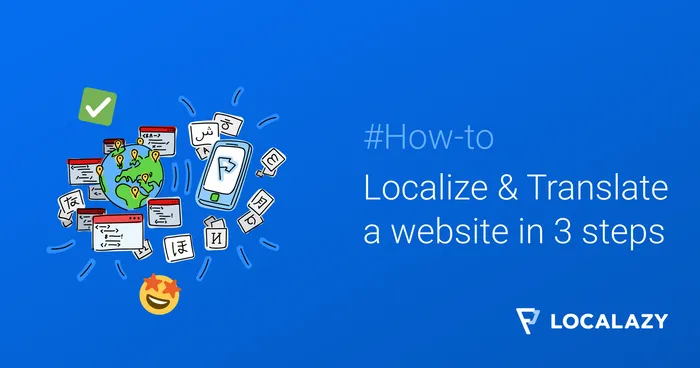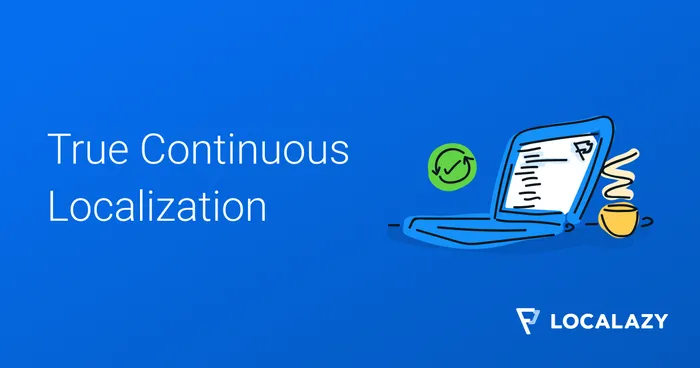There are many possible outcomes of localization. One company’s localized content can make waves, while another’s comes out a poor, watery imitation of the source. Or, one company manages to streamline processes and get their metrics on an upward trend, while another still fights manual assignments and delayed deadlines. Why does this happen? What’s the magical switch you can flip? What fairy dust can you scatter to get your localization processes to just work? ✨
The bigger the role of content within an experience, the bigger the impact localization has. And so localization, lately, is getting more and more of an impact. If it’s brought in at an early stage and localizers get a say, you can ensure the entire process works more smoothly, and the end result is better. But it’s a team sport, and so it can’t happen without cooperation from your colleagues. The magic I just described happens when teams across your organization – from researchers talking to potential users to designers putting together those wireframes, to developers coding late into the night – work together for that common vision.
Unfortunately, many still see localization as the thing that comes after. Something not in their realm of responsibility. And so it’s hard to convince them to get involved or collaborate effectively with localization stakeholders. Many localizers struggle to get their colleagues to just care, as they seemingly don’t. But in reality, it’s not that they don’t care: they just don’t think it has anything to do with them.

🤔 Why doesn’t anybody else care about localization? 🔗
Up until recently, it was assumed that localization should be a separate function within the organization. It happened at the end, after everything else was done. It involved lots of other people you didn’t want to be bothered about, often freelancers and external vendors. It impacted several different organizational functions, like product design, customer support, and marketing. And it was impossibly hard to budget, so no one really wanted to have loc under them.
We now know that localization, or at least product localization, should be part of the design process – and the earlier, the better. ☝️ And when you have efficient tools like Localazy, management and budgeting are less of a hassle. And so there’s really no reason for localization to be siloed anymore.
Up until recently, localization was seen as an end process that involved managing external resources and that was hard to budget. No one really wanted to have loc under them
The problem: No one told your colleagues. To them, it seems like a black box, something they don’t know enough about and can’t really influence. 🗃️ An added box they need to check, on top of their day-to-day tasks, that’s there because it’s good for the bottom line to have more users for the product.
This is bad, but it’s also good. Because understanding their motives means you can convince them. With some careful considerations and a bit of evangelizing, you can get your colleagues to care about localization: understand its importance and impact, and collaborate with you to make it better.

👐 How can you foster a localization-friendly culture within your company? 🔗
1. Use data and success stories 🔗
A great way to show the impact localization has is through numbers. Go through your own analytics or search for studies and data available. Try and find proof of the value localization can provide. This could be in various forms. For example:
- 📈 Numbers showing sales increases post-localization.
- 📊 Data about more website visitors from those places.
- 🏆 Increases in customer engagement or satisfaction ratings in localized regions.
- 📉 Reduction in customer support queries due to clearer, localized information.
- ⭐ Higher app store ratings or more positive reviews in regions where localization has been implemented.
Then, try and find examples of other companies doing localization well. Go through case studies online, listen to podcasts like the Localization Process Pod, or attend conferences and lectures to get some ideas. These stories will support the data and ground it in reality, showing why localization is so important.
2. Organize training sessions 🔗
A lot of the time, people avoid taking part in localization efforts as they don’t really know what those entail. Training and knowledge-sharing can shed some light on the process and help fix that. 👩🏫 Plan sessions where your colleagues can learn about localization. You can start from the basics, explaining why localization matters and showing some examples. Or you could share how-tos, tips, and tricks for localization in different areas, like marketing or product design. When they did this at Quandoo, for example, they saw significant interest in localization within the team.
If possible, bring in experts to talk about their experiences and create interactive sessions where everyone can participate. This will help them understand localization better. It will also give them a chance to ask questions and share their own ideas so that they will feel part of the process. Once people get a glimpse into this wonderful world, they are often much more inclined to help.

3. Show impact: user stories and feedback 🔗
Real user stories and feedback are powerful. Collect stories about how your users have gotten value from your localized product. Go through case studies, or talk to them directly to ask about the impact. Share positive feedback post-localization and gather anecdotes of instances where localization mattered. All of these will make the impact of localization feel more real.
In the end, localization is not just about business growth. It's about making things better for people all around the world. Also, share positive feedback from these users. When your colleagues hear how happy people are with the localized product, they'll be more motivated to invest in it and give it thought.
4. Understand the impact each role has 🔗
Every role in a company can contribute in a unique way to the localization-friendly culture:
- The CEO or Founder can prioritize localization in their vision and strategy, highlighting its importance.
- The CTO or developers can lead the development of systems that support multiple languages and cultural formats, ensuring that the product architecture is flexible enough.
- The CMO can make sure marketing and content strategies are tailored to each locale so that they resonate with diverse cultural audiences.
- Product managers can connect the different teams, facilitate collaboration, and ensure that localization is integrated into the product development cycle.
- Localization managers can ensure information and questions move seamlessly between all parties.
By understanding and embracing their specific roles in the localization process, each organization member can contribute to building a truly global and culturally aware company. This collective effort not only enhances the company’s market reach but also strengthens its brand on a global scale.
5. Empower colleagues within their roles 🔗
People don’t like to feel like a cog in the machine. When your colleagues feel like they have a big impact and a significant role in localization, they’ll consider it their own, too.
To this end, take time to explain how each team’s or person’s work contributes to this goal – just like they did at Despegar. For example, tell your design team how consistently creating screenshot context 🔍 for localization improves the quality of the localized experience. Or show your developers how collaborating with linguists when incorporating ICU syntax 📇 can ensure users get the correct copy in every language.

Treat localization as a collaborative effort (after all, that’s what it is). Encourage everyone to work together, have regular sync meetings or conversations, and share their successes and challenges.
When people see how their work fits into the bigger picture, they feel more involved. They understand that they're not just doing their usual job. They're part of something bigger that helps people all over the world.
🎙️ Listen to our Bridging the Gap podcast episode with Kareem Ennassag, for pracitical advice on building Language Operations (LangOps) for growth from the start.
6. Share improvements and give credit 🔗
Change and improvement happen gradually, in small increments. Focus on the good changes that the localization strategy contributed to – either fully or partially. Maybe more people are buying your product in a new country. Or maybe customers are happier. Share these improvements with everyone.
To help your colleagues feel a part of your company’s localization efforts, give them credit. 👏 Talk about the changes they caused and the difference their expertise made. You can do this through a shout-out in your weekly meeting or a note in a company newsletter. Anytime works, as long as you recognize people for their work and efforts.
Treat localization as the collaborative effort that it is. Explain team members what they can contribute, encourage them to work together and give your colleagues credit when they make a difference
7. Enlist advocates within each team 🔗
If you’re working at a large company, or if you’re the only localization person in your organization, you’ll need extensions. 😬 Find other people in the company who have a connection with localization and will be good advocates for your cause, like the localization team did at Wix. These people will act like a bridge between their team and your localization team, and help keep localization on everyone’s mind.
The colleagues you choose don’t have to be localization professionals – far from it. But they should care about your localized experience and understand the struggle of those using localized products. Those who speak more than one language are good candidates, as are writers and content designers who understand the impact of well-written content on the experience. This way, every part of your company will have someone to keep localization a priority.
📏 There’s never a one-size-fits-all solution 🔗
Every company is different, from structure and size to localization maturity. This means you’ll have to approach this in a different way, depending on how your company is built and how it operates. Take the recommendations in this article as a starting point, and adapt them as needed.
For example, if you’re a seed-stage company, your team will likely be small and your resources limited. Every person on the team will have their hands full, some filling more than one role at a time. This means you’ll know everyone personally and that you'll be able to reach out when you need to. You may need less automated processes and more hands-on collaboration, which can help everyone learn about localization just by being an active part of it.

If you’re already in growth, scaling is probably a concern. This is the time to figure out processes you can replicate – for every localization task or every new language you add. Now would also be a good time to bring in solid localization software, as migration will be easier the earlier you do it. 🪁 That’s what they did at ROUVY, and it worked wonders.
And if you’re expanding, size and spread may be a big issue. But on the other hand, you’re likely to have the capacity to hire several dedicated localization staff members, or even several teams – ensuring they can spread their efforts and foster collaboration with other teams, as well.
💭 Whether you're a seed startup, a scale-up or an established business wishing to expand, learn how to get started with Localazy's getting started guide.
🌸 The long-term benefits of a localization-friendly culture 🔗
Embracing localization as a core element of your business strategy isn't just about expanding your reach; it's about building lasting connections with your audience, no matter where they are. By integrating localization into every aspect of your company, you can make your global presence more cohesive, culturally sensitive, and ultimately successful.
Localazy stands as a testament to the power of thoughtful localization. By providing continuous localization services, Localazy helps businesses like ROUVY not only speak the language of their customers but also connect with them on a deeper level.
Localization isn't a hurdle to overcome; it's an opportunity. With these tips and the right tools, you can build a company culture that not only embraces localization but thrives on it.




